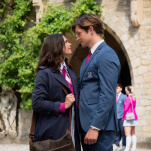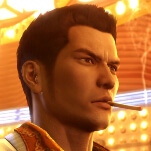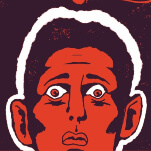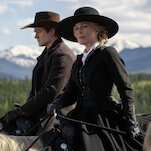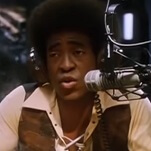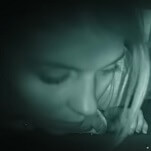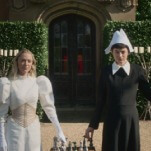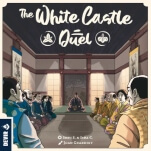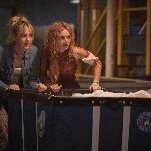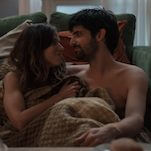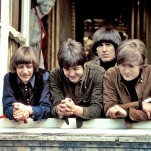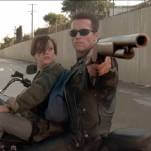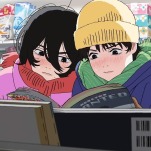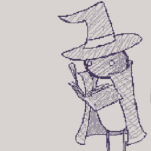Miyamoto Musashi, one of a slew of patriotic films about swordsmen produced in wartime Japan, is the closest thing to a B-movie that survives from the work of the great director Kenji Mizoguchi. In it, a brother and sister ask the famous rōnin Miyamoto Musashi (subject of countless films, many of them also titled Miyamoto Musashi) to help defeat their father’s killers, the Samoto brothers, who in turn seek out the master swordsman Kojirō Sasaki. Both Musashi and Sasaki—played by Chôjûrô Kawarasaki and Kan’emon Nakamura, respectively, the stars of Mizoguchi’s two-part wartime masterpiece, The 47 Ronin (1941-42)—are real historical figures, and the consensus is that they really did duel on the beach of a remote island and that Musashi did in fact come armed with a wooden sword. The rest is fiction.
A mere 53 minutes long, made quickly and very cheaply, Miyamoto Musashi is eerily minimalist, reverting at every opportunity to a mythic stillness. Nominally, it was a propaganda film, made in 1944, as the Japanese war effort was entering its last hopeless stretch. Mizoguchi himself was a contradictory figure. He was one of the defining artists of the camera; his sublime tracking shots are haunted by dramatic subtleties, and his delicate characterizations are steeped in a sense of moral tragedy that can only be called feminist. But he was also erratic, immature, and self-centered, a dilettante whose own relationships with women were conflicted, very turbulent, and sometimes even violent. Those who worked with him closely tended to paint Mizoguchi as equal parts uncompromising and opportunistic.
It was his knack for ingratiating himself to authority that allowed Mizoguchi to make his first postwar masterpiece, Utamaro And His Five Women (1946), despite the American occupation’s standing ban on samurai-era period films. He would later claim to have accepted Miyamoto Musashi as an assignment purely to avoid actual military service. (His contemporary Yasujirō Ozu, the master of domestic drama, had lucked out with a posting to a propaganda unit in occupied Singapore, where he spent most of his time watching confiscated American movies like Citizen Kane.) Only a third of the movies Mizoguchi directed in his lifetime survive to the present day, which makes him, percentage-wise, the most lost of the medium’s widely acknowledged masters. Out of those surviving films, Miyamoto Musashi ranks as one of the strangest.
On the one hand, it’s very symmetrical: two pairs of siblings, two rival swordsmen, and later, two deaths to avenge. (There’s also Musashi’s signature technique: two swords.) But Mizoguchi’s direction is ambiguous. He denies the punctuation or closure often provided by close-ups. Instead he directs in long takes, shifted into abstraction by meager resources. One scene between Musashi and the revenge-seeking sister, Shinobu (Kinuyo Tanaka, the star of Mizoguchi’s postwar masterpieces, including Ugetsu and Sansho The Bailiff), is staged as a wide shot in a darkened room where neither character is very visible. The director’s usual verisimilitude seems to have been a low priority: The sword fights, which often involve multiple combatants, are directed in wide, extended tracking shots that highlight their bloodless theatricality.
Musashi’s and Sasaki’s faces are painted in intensified makeup that makes it look like they wandered into the countryside straight off a stage. Mizoguchi’s camera, which was often close to metaphysical in its presence, had a habit of following characters even as they passed out of view, gliding over the surface of a wall until they reappeared at a corner or doorway. In Miyamoto Musashi, which was shot mostly outdoors or on simple sets, this camera is often linked to Musashi himself. He is an otherworldly and almost cosmic figure. In one of the great images of the film, he washes the blood off his sword in a waterfall, a beam of light breaking through above as though in a romantic painting.
Poetry in film is often expressed in the extraneous. But with its short running time and compressed narrative—exaggerated further by the fact that most of the scenes are directed in single takes—Miyamoto Musashi is a movie with no fat and no room (or budget) for anything except the bare necessities. Instead everything in this creaky shoestring 17th-century rōnin movie is mystified or connected through ellipses, to the point that some essential functions of the plot become obscure. What you end up with are figures in a creepy emptiness (forests, clearings, barely furnished interiors) and the mysterious force that seems to draw the camera to Musashi—who, like all of the characters in the film, is barely a character at all. Through its technical imperfections, it finds a path to an almost perfect transcendent endpoint: As Musashi and Shinobu part ways for the final time, the camera tracks with the swordsman, until he finally outpaces it and slips out of frame.





